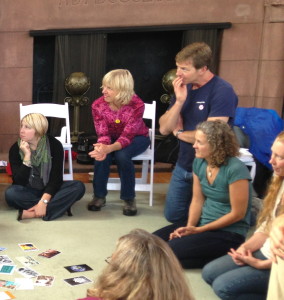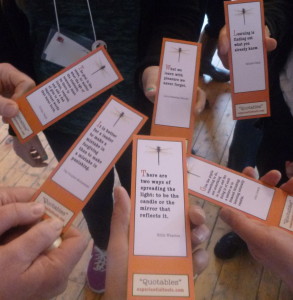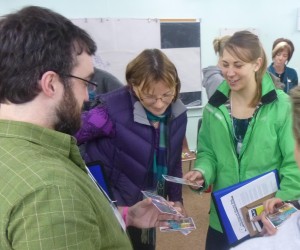Dec 18, 2013 The Brain, Learning, and Reflection
A century ago, John Dewey emphasized the importance of engaging learners in reflection. He believed that our experiences shape us, and when reflective practice is part of the learning, meaning and relevancy is created, initiating further growth and change (Dewey, 1933). Reflection is a key tenet of experiential education philosophy.
 As I mentioned in Monday’s post the modern day field of educational neuroscience reinforces this tenet of experiential education by showing us that we are indeed shaped by our experiences and continue to be throughout our lives. Educational neuroscientists emphasize that intentional engagement in reflective practice is key to “cementing” learning and enhancing application, transfer, retention, and recall. It does so by facilitating patterning and meaning making, creating multiple pathways to learning, and providing a forum for feedback.
As I mentioned in Monday’s post the modern day field of educational neuroscience reinforces this tenet of experiential education by showing us that we are indeed shaped by our experiences and continue to be throughout our lives. Educational neuroscientists emphasize that intentional engagement in reflective practice is key to “cementing” learning and enhancing application, transfer, retention, and recall. It does so by facilitating patterning and meaning making, creating multiple pathways to learning, and providing a forum for feedback.
Patterning is the word neuroscientists use to describe how the brain searches for patterns to construct meaning from input received. Learning takes place when the brain uses these patterns and attaches meaning to them. Brain researchers are finding that knowledge increases through pattern recognition and by matching new information to memories. This creates more extensive neural networks. We tend to remember things if we think we have seen them before. When new information is recognized as related to prior knowledge, learning extends beyond the domain in which it occurred—transferring to new learning and problem-solving situations (Willis, 2010). Positron Emission Tomography (PET) scans show that when people are given new information their brains activate the stored memory banks. When these connections are made long-term memory is enhanced.
When learners retrieve or reflect upon experiences they are activating neurons helping more dendrites to grow and interconnect increasing long-term memory storage. Memory is enhanced when learners understand the connections and relationships between prior learning experiences and new learning experiences. Reflection enhances this process by allowing learners to explore the patterns that connect the experience with real life application, context, personal meaning and relevancy. This creates stronger and more numerous neuronal connections or “pathways” to learning.
 Multiple-pathways to learning: Powerful experiences, ongoing practice, and varied stimuli enhance multiple-pathways to learning. The more ways a learner reflects upon and applies the information learned i.e. through movement, artwork, writing, social-interaction etc. and the more “personal” the learning experience is, the stronger the neuronal connections and the more pathways to storing and recalling the information are created.
Multiple-pathways to learning: Powerful experiences, ongoing practice, and varied stimuli enhance multiple-pathways to learning. The more ways a learner reflects upon and applies the information learned i.e. through movement, artwork, writing, social-interaction etc. and the more “personal” the learning experience is, the stronger the neuronal connections and the more pathways to storing and recalling the information are created.
Relevancy and Meaning: Our brains search for meaning and relevancy in lessons. We pay attention to and remember information that is relevant to our survival, interesting to us, and useful in promoting our success. Meaning creates important structure around detail. When we have association or context to a lesson—an emotional connection and sense of relevancy in regards to learning—we are more likely to remember it than we are random facts. Reflection and metacognition (thinking about thinking) enhance this process of meaning making by intentionally helping learners explore the patterns that connect the experience with real life application, context, personal meaning, and relevancy. Reflection helps learners understand HOW information is relevant to them and specific ways they will apply the information learned in the future. Reflective practice fosters an emotional connection to the material being learned. Reflection also provides a forum for the ongoing feedback emphasized by educational neuroscientists as key to learning.
 Feedback: Educational neuroscientists such as Dr. Judy Willis emphasize the importance of ongoing feedback throughout educational experiences to promote strengthening of neural networks. When learners can see their progression and receive ongoing feedback about what they did well and what they need to do to improve, intrinsic motivation is increased because they see the work as what Dr. Willis calls an “achievable challenge” (Willis, 2011). According to Dr. Willis when learners see that they have progressed through a challenge-even if it is not complete, they experience a pleasurable dopamine response and increased intrinsic motivation to continue learning. Ongoing reflective practice is a vehicle for providing this feedback and support to promote buy in, ownership over learning, and a positive view of learning.
Feedback: Educational neuroscientists such as Dr. Judy Willis emphasize the importance of ongoing feedback throughout educational experiences to promote strengthening of neural networks. When learners can see their progression and receive ongoing feedback about what they did well and what they need to do to improve, intrinsic motivation is increased because they see the work as what Dr. Willis calls an “achievable challenge” (Willis, 2011). According to Dr. Willis when learners see that they have progressed through a challenge-even if it is not complete, they experience a pleasurable dopamine response and increased intrinsic motivation to continue learning. Ongoing reflective practice is a vehicle for providing this feedback and support to promote buy in, ownership over learning, and a positive view of learning.
As a proponent of reflective practice in education and group work, I am excited about the research on the brain and learning that helps us understand WHY reflection is such a key ingredient to learning. For more reading on this subject check out these valuable resources on the brain and learning:
Medina, John. (2008). Brain Rules: 12 Principles for Surviving and Thriving at Work, Home and School. Seattle, WA: Pear Press.
Willis, Judy. (2006). Research-Based Strategies to Ignite Student Learning. Alexandria, VA: ASCD.www.radteach.com (Judy Willis’ website)
Wang, Sam and Aamodt, Sandra. Welcome to Your Brain (2008)
Wang, Sam & Aamodt, Sandra. (2011) Welcome to Your Child’s Brain. Bloomsbury Publishing. Their website also has great resources:
http://www.welcometoyourbrain.com/
References:
Dewey, J. (1933). How We Think: A Restatement of the Relation of Reflective Thinking to the Educative Process. Boston: D.C. Heath.
Dewey, John. (1938) Experience and Education. New York: Macmillan Publishing Co.
Willis, Judy (2010) ASCD Edge “Want Children to Pay Attention? Make Their Brain’s Curious. www.radteach.com (Judy Willis’ website)



No Comments